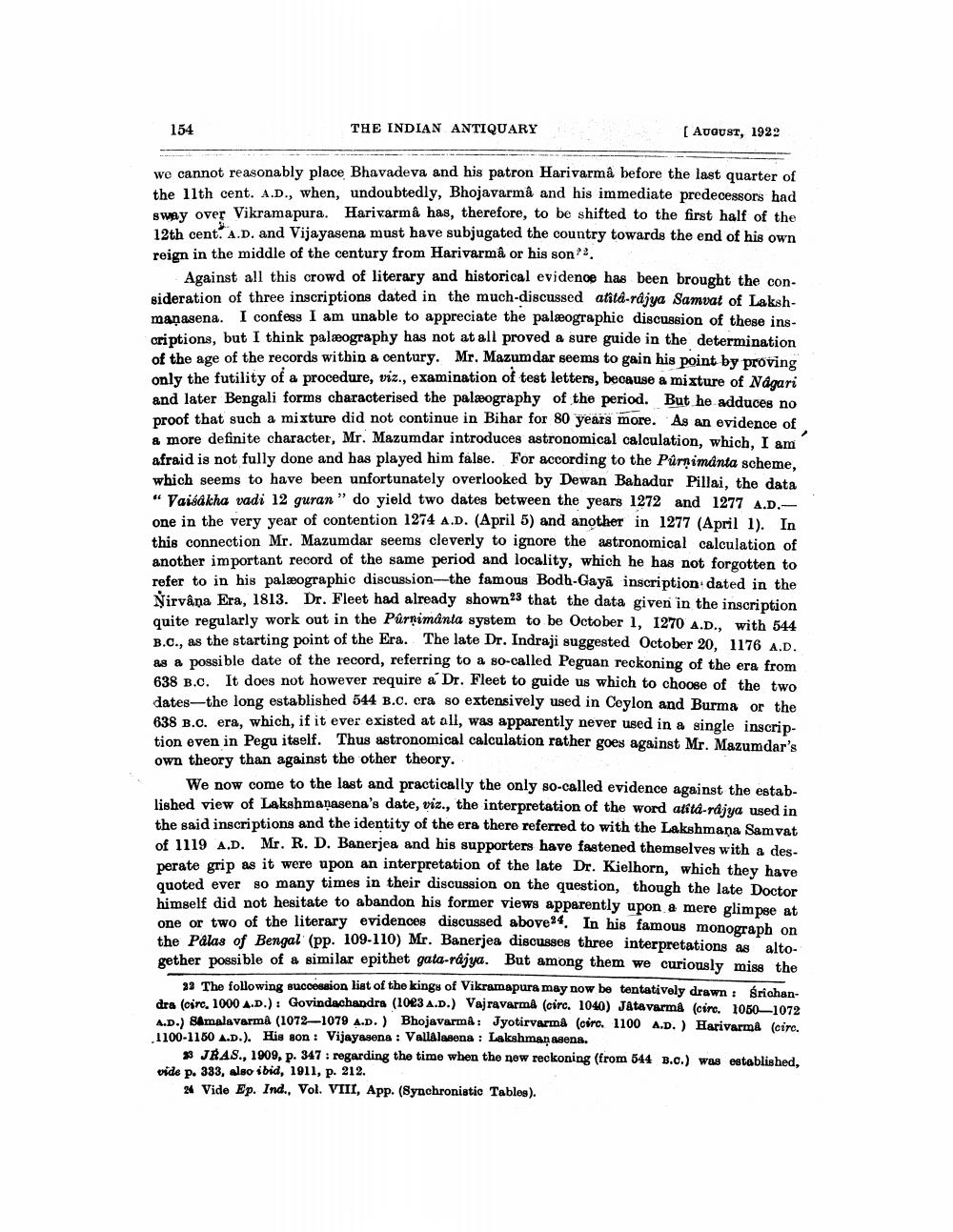________________
154
THE INDIAN ANTIQUARY
(August, 1922
we cannot reasonably place Bhavadeva and his patron Harivarmå before the last quarter of the Ilth cent. A.D., when, undoubtedly, Bhojavarma and his immediate predecessors had gway over Vikramapura. Harivarma has, therefore, to be shifted to the first half of the 12th cent. A.D. and Vijayasena must have subjugated the country towards the end of his own reign in the middle of the century from Harivarma or his son .
Against all this crowd of literary and historical evidenoe has been brought the consideration of three inscriptions dated in the much-discussed atita-rajya Samvat of Lakshmanasena. I confess I am unable to appreciate the palæographic discussion of these inscriptions, but I think palæography has not at all proved a sure guide in the determination of the age of the records within a century. Mr. Mazumdar seems to gain his point by proving only the futility of a procedure, viz., examination of test letters, because a mixture of Nagari and later Bengali forms characterised the palæography of the period. But he adduces no proof that such a mixture did not continue in Bihar for 80 years more. As an evidence of a more definite character, Mr. Mazumdar introduces astronomical calculation, which, I am afraid is not fully done and has played him false. For according to the Purnimanta scheme. which seems to have been unfortunately overlooked by Dewan Bahadur Pillai, the data « Vaisakha vadi 12 guran" do yield two dates between the years 1272 and 1277 A.D.one in the very year of contention 1274 A.D. (April 5) and another in 1277 (April 1). In this connection Mr. Mazumdar seems cleverly to ignore the astronomical calculation of another important record of the same period and locality, which he has not forgotten to refer to in his palæographic discussion-the famous Bodh-Gayā inscription dated in the Nirvana Era, 1813. Dr. Fleet had already shown that the data given in the inscription quite regularly work out in the Pärnimanta system to be October 1, 1270 A.D., with 544 B.C., as the starting point of the Era. The late Dr. Indraji suggested October 20, 1176 A.D. as a possible date of the record, referring to a 80-called Peguan reckoning of the era from 638 B.C. It does not however require a Dr. Fleet to guide us which to choose of the two dates-the long established 544 B.C. era so extensively used in Coylon and Burma or the 638 B.C. era, which, if it ever existed at all, was apparently never used in a single inscription even in Pegu itself. Thus astronomical calculation rather goes against Mr. Mazumdar's own theory than against the other theory.
We now come to the last and practically the only so-called evidence against the established view of Lakshmanasena's date, viz., the interpretation of the word atita-rajya used in the said inscriptions and the identity of the era there referred to with the Lakshmana Samvat of 1119 A.D. Mr. R. D. Banerjea and his supporters have fastened themselves with a desperate grip as it were upon an interpretation of the late Dr. Kielhorn, which they have quoted ever so many times in their discussion on the question, though the late Doctor himself did not hesitate to abandon his former views apparently upon a mere glimpee at one or two of the literary evidences discussed above. In his famous monograph on the Palas of Bengal (pp. 109-110) Mr. Banerjea discusses three interpretations as alto. gether possible of a similar epithet gata-rajya. But among them we curiously miss the
13 The following succession list of the king of Vikramapura may now bo tentatively drawn friahandes loiro, 1000 A.D.): Govindachandra (1023 A.D.) Vajravarma (circ. 1040) Jatavarma (circ. 1060—1072 4.p.) 8Amalavarma (1072-1079 A.D.) Bhojavarma: Jyotirvarma (circ. 1100 A.D.) Harivarme (cire. 1100-1150 A.D.). His son: Vijayasena : Vallalasena : Lakshmanasena.
> JRAS., 1009, p. 347 : regarding the time when the new reckoning (from 544 B.C.) was established, vide p. 333, also ibid, 1911, p. 212.
# Vide Ep. Ind., Vol. VIII, App. (Synchronistic Tables).




